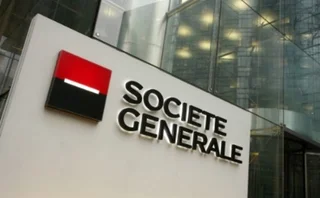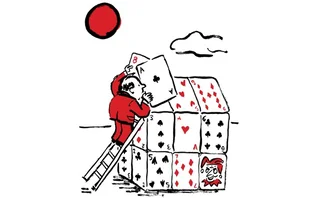
Saving structured finance: Dealers vie for SPV replacement swaps
A few large banks are renting out their credit ratings to protect structured finance vehicles from downgrades. But it’s a complex business, and it can come at a heavy cost to the original counterparties. By Lukas Becker

Sliding credit ratings and rising funding costs are making life awkward for European banks that have traded interest rate and cross-currency swaps with the special-purpose vehicles (SPVs) used in structured finance deals. The two-step downgrade triggers written into the ratings criteria for those deals mean many swap providers now have to post collateral to insulate the vehicle against their default, while others have reached the point of no return – the second trigger level – and have to pay a replacement counterparty to step in.
The new swap provider becomes subject to the deal’s rating-triggered obligations, so the trick is to structure the replacement trade in a way that provides cast-iron protection. Typically, that means the original counterparty retains both the funding and replacement cost exposure but it could be the only way to prevent the SPV being downgraded. As of August, ratings on 67 Italian and Spanish covered bonds had been cut this year, according to Moody’s Investors Service, partly to reflect ratings cuts for Italy’s banking industry.
About six of the big dealers are said to be vying to provide these replacement swaps, including Barclays, Deutsche Bank, HSBC and Société Générale. It’s not a new business, but demand has exploded since European banks suffered sweeping downgrades in the second quarter. At the same time, the number of viable providers has shrunk because many dealers are at or below the first trigger level themselves. For the remaining names, the business has become newly lucrative – the industry is more sensitive to the contingent risks embedded in the deals, the original swap providers are in a tight spot, and competition from second-tier and regional banks in Europe has also fallen away.
“A couple of years ago, we’d be in competition for a trade and would be told that other quotes were much, much tighter – frankly underwater, if we looked at the trade at that level,” says one structured finance head at a European bank. “Slowly, we’ve seen players that were doing things at a suicidal level exit the market, or we’ve seen them widen out their pricing to more sensible levels to reflect the fact that you’re signing up to a contingent collateral obligation and are subjecting yourself to a ratings trigger.”
Thomas Decouvelaere, European head of structuring for rates and foreign exchange at Société Générale Corporate & Investment Banking (SG CIB), says that over the past four years the pricing of structured finance swaps was so unattractive the bank stayed out of the market. “There was too much uncertainty, and pricing-wise it was very competitive. Now the market has repriced – the fees that used to be in the area of one to two basis points running are now closer to 15 basis points running. And the banks that need a replacement have less room to negotiate documentation,” says Decouvelaere.
Fees that used to be in the area of one to two basis points running are now closer to 15 basis points running
There is plenty of business to go round. Moody’s reported in August that 165 residential mortgage-backed securities (RMBS) in Europe had hit their replacement trigger, for example – and the original providers are keen to find new counterparties before the deals are downgraded in turn (Risk May 2012, pages 16–20). “We are looking for replacement counterparties or guarantors to take our place or guarantee our position in the transaction if the bonds were sold in the markets,” says a spokesperson for Santander – the swap counterparty to 21 RMBS transactions that have breached their second-level trigger.
Enough replacements?
One question facing institutions like Santander is whether there are enough potential replacements. Of the G-16 group of international dealers, half are either on their first or second trigger, according to Moody’s structured finance ratings methodology, but Edward Manchester, senior vice-president with the agency in London, says the assumption is that it should be possible for every threatened deal to find a replacement (Risk September 2012, page 8).
“I think it's premature to say that there's insufficient liquidity in the market to absorb the bulk of these swaps. That's not our working assumption, but if it proves to be the case, we would certainly reconsider,” he says.
The actual number of swap transfers that have been completed is not clear – speaking anonymously, dealers say they have done anywhere from three to 10 trades; one bank gives the impression it has been busier than that, but declines to provide a number. The rating agencies also decline to give the exact number of replacement trades, however Andrew Bowyer, a director at Standard & Poor’s in London, says more than half the Spanish entities that breached their replacement trigger prior to the October 10 downgrade of Spain have managed to find new swap providers – with most of the rest choosing to restructure their swap documentation instead. The latter option can seem more palatable, but it makes it impossible for the deal to achieve a higher rating than that of the swap counterparty.
“If the transaction ratings have already been downgraded to a certain level, it would theoretically be possible for counterparties to restructure their obligations by adjusting their replacement triggers to a lower level – but the note trustee would need to accept the fact that this is potentially putting a ceiling on the rating of the transaction. Should the counterparty or sovereign ratings improve, the deal may not be able to be upgraded unless the documentation is changed again,” says Bowyer.
Another alternative is for a third party to act as guarantor, but this arrangement is unpopular for a host of reasons (see box, Unpopular guarantees). As a result, dealers say the most common way to shore up structured finance deals is to set up a so-called back-to-back structure in which the new bank acts as a ratings intermediator (see figure 1). The bank that has breached its second trigger – the exiting bank – novates its swap with the SPV to the replacement bank, forming what’s known as the front swap. Where previously the exiting bank’s low credit rating had it paying out collateral to the SPV, the replacement bank’s superior rating means it doesn’t have to post any collateral.

The exiting bank, meanwhile, provides a hedge to the replacement bank, taking the opposite side of the trade – this is the back swap.
The terms of the front swap are invariably unpleasant. The replacement bank inherits a one-way credit support annex (CSA) in favour of the SPV – meaning collateral has to be posted to the vehicle when it is in the money, but the dealer doesn’t receive anything in return when the value of the trade flips round. To counteract this, the replacement bank will sign either a two-way CSA or a one-way CSA – in its own favour – on the back swap. If the latter is the case, a replacement counterparty that is in the money for the front swap would receive no collateral from the SPV, but would also not have to post anything in the back swap; if the value of the trades reversed, it would have to post to the SPV, but would also be receiving collateral from the exiting bank.
Collateral posting only happens at all if the replacement bank breaches the first trigger level, of course – so the trade should be funding-neutral for it – and should remove any funding obligation on the part of the exiting bank unless the replacement is downgraded. Things get a little more complicated if the exiting bank defaults on the back swap, says a structured finance trader in London.
“Until the back swap party defaults, you don’t need to put on any specific market hedge, because any flow that is due on the front swap is received on the back swap, and any mark-to-market move on the front swap is compensated by the mark-to-market on the back swap. But in the event of a default by the back swap counterparty, you will need to collect from them an amount that compensates for the hedge you need to put in place at that time,” he says.
While the structure itself is relatively straightforward, dealers say the risks involved are not – funding exposure being the key. This exposure is tied to the replacement bank’s own creditworthiness, and could result in the dealer having to post margin to cover the market value of the swap or, depending on how far the bank has been downgraded, an extra independent amount, also known as a volatility buffer. That buffer can amount to double-digit millions of dollars (see box, Ratings criteria and OTC swaps).
LCR considerations
The potential funding obligation also needs to be factored into the bank’s liquidity coverage ratio (LCR), one of two new liquidity standards introduced by the Basel III prudential rules. The LCR requires a bank to hold enough safe assets to cover its liquidity needs over a 30-day period of stress, and those needs have to reflect any collateral posting obligations triggered by a three-notch downgrade.
“Generally, banks are within two notches of having to post collateral, so you have to take into account the fact that liquidity needs to be reserved. Either you price it or ask the bank to provide it directly through a back swap,” says Decouvelaere of SG CIB.
The best way to mitigate this risk is to fund it, but Guido Hebert, global head of rates structuring with HSBC in London, says he sees some banks underestimate the term risk – that is, the longer the tenor of the trade, the greater the chance the replacement bank will be downgraded and will have to increase the amount of liquid collateral it needs to hold for the LCR.
A second risk is more difficult to analyse: the risk that the replacement bank will itself have to find a new counterparty if it gets downgraded to the second trigger (Risk September 2011, pages 94–96). Hebert says this risk is a big concern to most dealers. It is tough to predict a downgrade, it could result in the need to post a volatility buffer, and would leave the replacement counterparty in the same position as today’s original swap providers – depending on other institutions with higher ratings to step into the trade.
“What if we don’t find anyone to take it over? Or they only want to take it at a very heavy discount? Clearly we have a substantial risk that we take on there, and that affects the kind of trades we’ll consider – the key criteria are the tenor, the underlying, how granular the portfolio is and how well we understand the assets,” says Hebert.
Often, replacement banks want to be indemnified against this risk by the banks they are replacing. That can involve putting a stand-by trade in place between the back swap and the front swap – effectively reinstating the original trade – which passes on the second replacement risks as long as the back swap hasn’t defaulted. In other words, if the replacement counterparty is downgraded and needs another bank to step in, the original swap provider reappears.
But Hebert is still wary. “This risk is completely unpredictable on a swap that is very costly to maintain in terms of funding. The market will be very small at that moment in time – that’s clearly a risk we don’t like. If we need to accept this kind of language, we watch what kind of trade we’re underwriting,” he says.
One structured finance trader at a bank in London says the SPV replacement swap business is the same as any other – but with a lot more optionality. “You’ve got to know how to price that optionality, the convexity in it, and use hedging strategies that you would in any exotic swap,” he says.
For the replaced bank, it all seems like a pretty crummy deal – the original counterparty has to pay through the nose for the replacement swap, often has to stump up an independent amount on its back-to-back trade with the replacement counterparty, and also faces a credit valuation adjustment charge as a result of a one-way CSA.
Another London-based interest rate trader, however, argues that is the price of having a higher-rated counterparty step into a risky situation. “If an Italian bank intermediated for another Italian bank, even if one was higher rated, how much comfort would you get that that in fact will help you in the long end? That’s why these transactions are not cheap,” he says.
BOX: Ratings criteria and OTC swaps
Over-the-counter derivatives are central to structured finance. A deal such as a residential mortgage-backed security (RMBS) or a covered bond rests on assets pooled within a special purpose vehicle (SPV), which typically enters into an interest rate swap with a dealer – usually the issuing bank, but not necessarily – to ensure cashflows generated by the underlying collateral are sufficient to meet the interest payments due to bondholders. Floating payments can be converted into fixed, and swaps can also smooth over any timing mismatches between the interest income from the underlying mortgages and payments to investors.
If the RMBS or covered bond is issued in a different currency to the underlying mortgages, the SPV can also enter into a currency swap to hedge the currency risk.
Often, these will be balance-guaranteed swaps where the notional value of the swap is tied to the value of the surviving loans, meaning the ones that haven’t defaulted or pre-paid.
Because derivatives are so important to the functioning of these deals, the reliability of the counterparty is a key element in the criteria used to rate them. As a result, the swaps often have built-in triggers that reflect the agencies’ criteria. Put simply, if a swap counterparty hits the first trigger level – A2 for long-term debt and P-1 for short-term in the case of Moody’s Investors Service – it has to post a certain amount of collateral based on the mid-market value of the swap and its predicted change in value over a given period.
If it is downgraded past the second trigger, which is currently Baa1 or P-2 for long- and short-term debt respectively, it has to post more collateral. That sum is based on an extension of the reference period in Moody’s case, and on the mark-to-market value of the swap plus a volatility buffer in the case of Standard & Poor’s (S&P).
These buffers can be punitive. Under S&P’s option one methodology – a common choice, according to one bank source – an out-of-the-money €500 million fixed-to-floating interest rate swap with a remaining average weighted life of 10 years would be required to post the mark-to-market value of the trade plus 4.5% of the notional, or €22.5 million, as the volatility buffer to support a vehicle’s A+ rating.
On top of the additional collateral requirements, the downgraded swap counterparty either has to find a replacement counterparty or a guarantor. If it doesn’t, it can affect the credit rating of the notes – capping their rating at the swap counterparty’s level.
This could be a big problem for Spanish and Italian banks that were downgraded in June and July this year. Banks such as Santander, BBVA and UniCredit all fell below the replacement trigger, meaning they have to take action, or risk the vehicle’s downgrade.
Ratings for some deals have already been cut. According to Moody’s, 14 Italian covered bonds have been downgraded this year, from an average credit rating of Aa1 to A2. Spanish deals have fared worse, seeing 53 downgrades, with the average credit rating moving from Aa1 to Baa1.
But the relationship between a swap counterparty’s credit rating and the downgrade risk for a deal is not straightforward. According to a September report from S&P, counterparty risks – which include exposure to a swap provider as well as other factors such as the loss of a bank account – are the limiting factor for around 15% of Spanish RMBS structures and around 10% of Italian RMBS.
Certain features of a swap can also have more of an effect than others. For example, cross-currency swaps carry more weight than interest rate swaps – because the mark-to-market value can be more volatile, depending on foreign exchange as well as interest rates – while a higher-rated vehicle will be more sensitive to swap counterparty ratings than a lower one.
“If you had a triple A note and there's a cross-currency swap providing a large amount of support for that tranche, and there's a relatively high probability that the swap is going to be lost, you'd generally be expecting a material impact on the rating,” says Edward Manchester, senior vice-president at Moody’s in London.
The time frame banks have to find a replacement or secure a guarantee is unclear – the ratings criteria usually refer to “commercially reasonable efforts” to find another counterparty – and the process could take some time. But Andrew Bowyer, a director with S&P in London, says it cannot be dragged out indefinitely.
“There is the risk that this just bounces on and on, while potentially the credit quality of that counterparty could be deteriorating, and you could eventually end up with a single-B bank supporting a highly rated transaction. For this reason we tend to want to move the ratings reasonably swiftly after the expiry of the replacement commitment period,” says Bowyer.
BOX: Unpopular guarantees
Once a second-level trigger has been breached, a swap counterparty to a structured finance deal has to do two things. First, to protect against default, it has to provide a collateral buffer; it then either has to replace itself in the trade or find a guarantor. While guarantees can often be obtained from a parent entity, dealers are not particularly interested in acting as a third-party guarantor.
“I think it’s generally cleaner to actually be the counterparty, as then you actually face the vehicle. You can talk to them as a counterparty, and you can get the information you need. I think it’s just a cleaner way of doing business,” says one structured finance trader at a European bank.
There is a way to do both, though. Edward Manchester, senior vice-president at Moody’s Investors Service in London, says he has seen around 12 structures where the initial swap between the downgraded bank and the special purpose vehicle (SPV) is retained, while a back-up swap between the SPV and a third-party bank is activated if the downgraded bank defaults.
“From a credit point of view they're quite positive because you've got the joint default protection - in order for the issuer to suffer a loss you need both the front counterparty and the standby to default. If they're not highly correlated and the front counterparty is investment grade, that's a low probability,” he says.
Only users who have a paid subscription or are part of a corporate subscription are able to print or copy content.
To access these options, along with all other subscription benefits, please contact info@risk.net or view our subscription options here: http://subscriptions.risk.net/subscribe
You are currently unable to print this content. Please contact info@risk.net to find out more.
You are currently unable to copy this content. Please contact info@risk.net to find out more.
Copyright Infopro Digital Limited. All rights reserved.
As outlined in our terms and conditions, https://www.infopro-digital.com/terms-and-conditions/subscriptions/ (point 2.4), printing is limited to a single copy.
If you would like to purchase additional rights please email info@risk.net
Copyright Infopro Digital Limited. All rights reserved.
You may share this content using our article tools. As outlined in our terms and conditions, https://www.infopro-digital.com/terms-and-conditions/subscriptions/ (clause 2.4), an Authorised User may only make one copy of the materials for their own personal use. You must also comply with the restrictions in clause 2.5.
If you would like to purchase additional rights please email info@risk.net
More on Securitisation
Global banks look for profits in China ABS market
Regulatory change provides opportunity for international firms' structuring skills
Credit fears hold back US solar securitisation deals
SolarCity deals show potential and pitfalls of new asset class
Collateral damage: Capital proposals threaten Europe's ABS market
Insecuritisation
Securitisation touted as answer to '€4 trillion' funding gap
Securitisation industry group claims Europe faces big financing shortfall – and pushes securitisation as the answer
SG plans to securitise €1.9 billion of derivatives exposure
Deal is said to pay a coupon of 11% for first-loss protection – which some investors say is too low
"Deceptive and negligent": How the first CPDO got its AAA rating
An extraordinary Australian court judgement shines a light on the errors and deceit that led to the granting of an AAA rating to ABN Amro’s Surf constant proportion debt obligation in 2006. Lukas Becker reports
Dutch counsel confident of success as S&P faces new CPDO case
The fine handed out by an Australian court last year to ABN Amro and Standard & Poor’s was a rare success for post-crisis litigants in structured credit cases. The victors are hoping to repeat the trick in Europe – but what are their chances? Lukas…







